Coronal mass ejection arrival, G2 geomagnetic storm
Tuesday, 17 March 2015 10:25 UTC

The coronal mass ejection likely associated with the C9 solar flare has arrived at Earth, much earlier than expected. A sudden increase in the solar wind and IMF parameters were observed but the direction of the IMF stayed north until around 06:00 UTC when it turned southward for a couple of hours to about -20nT. The geomagnetic field responded and a moderate G2 geomagnetic storm followed.

Image: OVATION model run for the northern hemisphere valid at 2015-03-17 09:15 UTC.

Image: Aurora Australis captured only moments ago by Eddie Griffiths from New Zealand.
Current conditions
Coronal mass ejection effects continue at the time of writing with the solar wind speed being close to 600km/s and the strength of the IMF being close to a high value of 25nT. The direction of the IMF is however pointing north now around 12nT which should cause the geomagnetic conditions to calm down a bit in the hours ahead. Nonetheless, the geomagnetic field is disturbed and more auroral outbreaks are possible. Sky watchers in Tasmania and Victoria (Australia) and the southern island of New Zealand along with the upper United States should remain alert for aurora providing skies are clear at your location.
It is still too early to tell what European sky watchers should expect but CME effects will likely persist for another 12 to 24 hours. The direction of the IMF could very well turn southward in the hours ahead which could spark more aurora over Europe this coming evening. Keep an eye on the stats as European evening hours approach.
Thank you for reading this article! Did you have any trouble with the technical terms used in this article? Our help section is the place to be where you can find in-depth articles, a FAQ and a list with common abbreviations. Still puzzled? Just post on our forum where we will help you the best we can!
Latest news
Latest forum messages
Support SpaceWeatherLive.com!
A lot of people come to SpaceWeatherLive to follow the Sun's activity or if there is aurora to be seen, but with more traffic comes higher server costs. Consider a donation if you enjoy SpaceWeatherLive so we can keep the website online!

Space weather facts
| Last X-flare | 2025/03/28 | X1.1 |
| Last M-flare | 2025/04/22 | M1.3 |
| Last geomagnetic storm | 2025/04/21 | Kp5+ (G1) |
| Spotless days | |
|---|---|
| Last spotless day | 2022/06/08 |
| Monthly mean Sunspot Number | |
|---|---|
| March 2025 | 134.2 -20.4 |
| April 2025 | 124.6 -9.6 |
| Last 30 days | 121.2 -9.9 |


